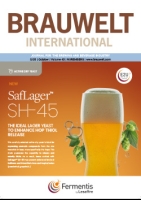As the Greek philosopher Thales of Miletus once said: “The principle of all things is water. Everything comes to be from water, and everything returns to water.” Telling this to brewers is stating the obvious, right? Or is it closer to reality to say that this valuable raw material is commonly handled without care, more along the lines of casting pearls before swine?
The comprehensive modernization of process control systems or the migration of automation software to state-of-the-art technology are major prerequisites for more efficient and competitive brewing processes. The Warsteiner Brewery has therefore recently converted the automation technology of its entire brewing plant to ProLeiT’s modern brewmaxx V8 process control system in several project steps. In this way, the company is creating ideal conditions for extra-high productivity; on the basis of integrated materials management, the company has for the first time also achieved consistent traceability for breweries. This multi-stage project clearly demonstrates that a fundamental modernization approach of this kind can only be successful if all of the operator’s and suppliers’ specialists cooperate as closely as possible. The automation specialists require a comprehensive understanding of brewing processes because this is the only way to successfully modernize brewing plants during production.
Gushing is a very multifaceted – and still unsolved – problem in the brewing industry. In recent years, numerous efforts were made to identify gushing promoters. Gushing is a temporary phenomenon that is primarily triggered by microorganisms or their metabolites. This contribution describes the basics in terms of the influence of hops. In a second part, results are presented that show that hop ingredients have a positive influence on the gushing behaviour of beer.
Significance | Microbiological quality assurance in breweries aims at establishing the microbiological condition of the individual steps in production and filling and of goods for sale. At any rate, infection sources that may contaminate or re-contaminate beer have to be identified. Such sources have then to be eliminated and, finally, successful elimination has to be proven. This experiential report contributes to minimising the “role of happenstance” by giving due consideration to the lower detection limit of a microbiological analysis. Influences arising from the sample volume (e.g. from pipes) and from the test volume on microbiological analysis results are presented.
Schmidt-Seeger GmbH with its GrainSELECT® system is ushering in a new era in the quality-orientated selection of malting barley and grain. Water, hops, yeast and malt are essential ingredients for brewing a good beer. As far as the malt is concerned, a homogeneous raw material is a major factor in obtaining an end product of consistently high quality and therefore the best recipe for creating strong customer ties.
To strengthen its reputation as a top quality brewer, Grupo Mahou-San Miguel has implemented an integrated quality management and traceability system based on an MES solution including a LIMS (Laboratory Information Management System), a material management module, and a product specification management system. This system allows the brewer to establish and enforce strict quality control throughout its organization.
Thermal sterilisation still plays an important role in microbiological stabilisation of beverages. Parameter setting (temperature-time curve) of pasteurisers, flash pasteurisers and UHT plants is based on a simplified calculation basis that does not take individual circumstances into account (e.g. microorganisms, environment). Many details about each individual sterilisation process are required in order to guarantee product safety so that heating plants can be operated at the lowest temperatures and for the shortest possible times. Such information is now available in a new database on the Internet.
The year 2009 saw the 100th anniversary of an innovation pioneered by the Carlsberg Research Center in Copenhagen, which has been of inestimable importance for every area of science and technology since its introduction. Of course, this refers to measuring the concentration of hydrogen atoms in a solution, otherwise known as pH. When one considers alone the simplification achieved through designating a neutral liquid (distilled water at 22 °C) as having a pH of 7, rather than containing 0.0000001 hydrogen ions per liter, the impact of this system of notation becomes very clear.
Since 1967 Anton Paar GmbH has specialized in providing highly accurate and reliable density meters for research and industry, developed in cooperation with Labor für Messtechnik Dr. H. Stabinger GmbH, Graz. The guideline “Good Density Measurement” sums up experience and insights into measurement practice of over forty years.
Latest innovative technology serving the users is provided by the TurbiGuard and PhaseGuard of Sigrist-Photometer. Depending upon selection these products can be used for interface detection and monitoring of medium to high turbidity in applications for process liquids. The sealless design of the sensor head with sapphire windows allows the use in nearly all process applications from filtration control in breweries to turbidity control in industrial or chemical processes.
In breweries, it is important to either kill off microorganisms (MO) that may pose a threat to drinking and process water, air and product or transform them into a state in which they cannot propagate at all or to a degree that can be tolerated. This contribution describes the disinfectants that can be used and how problem definition and task, water quality and disinfection processes can be reconciled.


